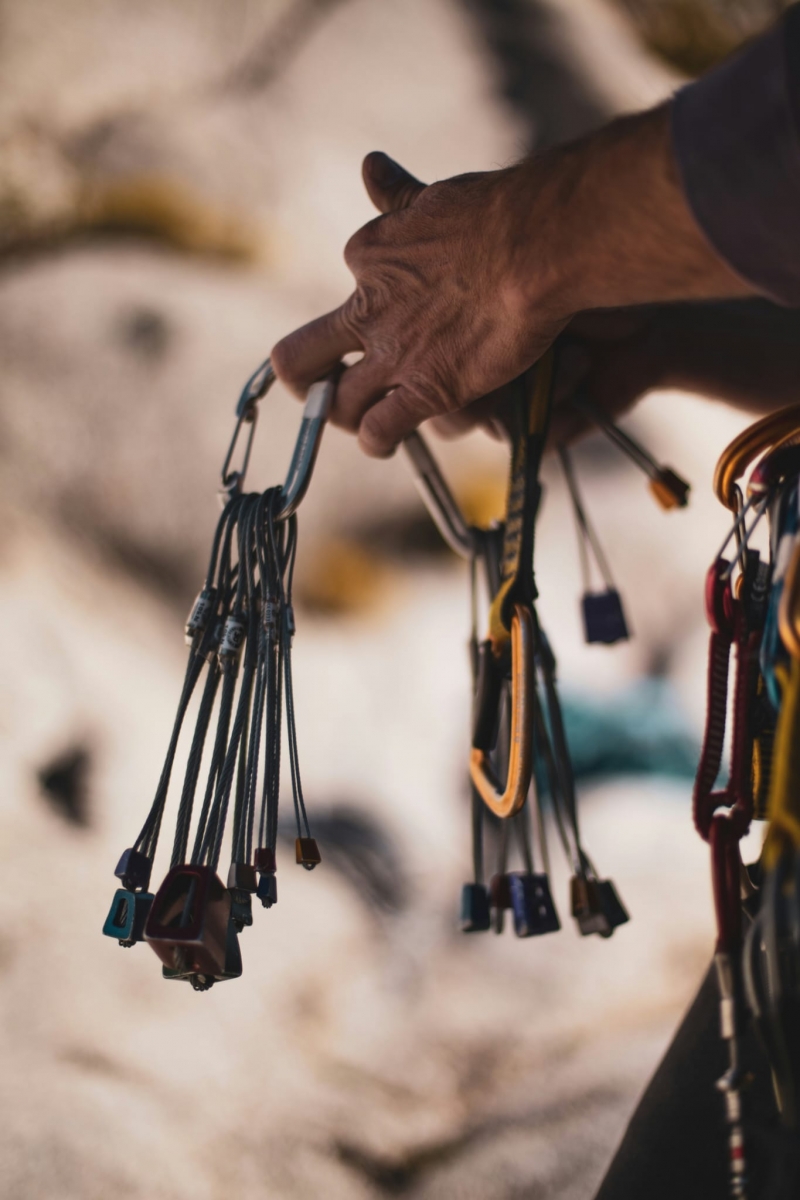Psychological Aspects of Elite Performance in New Olympic Disciplines: The Case of Climbing
Editor: Lisa Musculus-Schönenborn
Editorial assistant: Sofia Calderon
This article has also been translated into German and French.
In recent years, sports that have traditionally been practiced as recreational and non-competitive have been added in the official Olympic program. For example, climbing is on the Olympic program for Paris 2024 and Los Angeles 2028. This article provides an up-to-date overview of the relevant psychological aspects of climbing that are important for performance. We also discuss how sport psychology can contribute to current and future challenges in Olympic climbing. Image 1. A climber in preparation
Image 1. A climber in preparation
Over the past two decades, extreme sport-related recreational outdoor activities, such as alpinism and mountaineering, have evolved into competitive mainstream sporting disciplines. The continuous development of climbing as a competitive sport has contributed to its international growth in popularity since its first World Championships in 1991. Today, over 25 million people climb and it is included in the Olympic program.
The Paris 2024 Olympic Games climbing program includes three different disciplines, divided into two different events: “Speed climbing” is climbing a standardised route as fast as possible, and in “sport climbing” you participate in a combined competition of bouldering and lead climbing. In bouldering, climbers must solve a series of short, rope-less climbing sequences, called boulders, on low-height climbing walls, while in lead climbing, climbers attempt routes of at least 15 meters in length.
Early research on climbing focused on physiological parameters, motor skills such as grip strength and endurance, biomechanical aspects, and injuries. However, psychological aspects are a "a key element in accomplished climbers" [1, p. 852]. Early research mostly used climbing to study psychological aspects (e.g., imagery, anxiety), to modify climbing rules, and to adapt climbing routes to fit experimental designs and hypotheses. Afterwards, psychological research was made in settings that resemble what climbers actually encounter. Various streams of psychological work have emerged from this, including the nested affordance framework [2], the embodied planning approach [3], the movement repertoire paradigm [4], and the perception-cognitive framework [5].
Today, researchers agree that climbing performance is inherently associated with multiple and diverse determining factors. Amongst these, the psychological factors appear as pivotal to achieving optimal performance [6]. Indeed, it has been suggested that psychological aspects such as problem-solving ability, movement sequence recall, route finding, self-efficacy and stress management may be better predictors of climbing performance than physiological or biomechanical parameters.
Considering the increasing research on psychological aspects in climbing over the last decade, the purpose of this article is twofold:
1) Provide a state-of-the-art overview on relevant psychological aspects that are critical in climbing performance
2) To critically discuss how sport psychology addresses challenges related to Olympic climbing.
Psychological Aspects in Climbing
While a number of psychological parameters are relevant to climbing, this article will focus on the four most important psychological aspects [7][6]:
(a) Embodied planning: the interaction between cognitive and motor planning processes
(b) Route previewing: the visual inspection of routes and boulders before actual performance
(c) Climbing movement repertoire: domain-specific, high-level knowledge structures stored in long-term memory
(d) Risk management, including the identification and mitigation of potential risks associated with the activity to ensure safety practices.
We delve into each of them in detail in the following sections.
Embodied Planning
Efficient climbing strategies combined with skilled motor actions tailored to the demands of climbing are central to achieving optimal climbing performance [8][5]. In lead climbing, route planning primarily involves identifying appropriate climbing strategies before attempting routes, because climbers typically have only one attempt [6] (Sanchez et al., 2019). In bouldering, an additional factor is that climbers can make multiple attempts and adapt climbing strategies after a failed climbing attempt. Further, effective time management across attempts is a critical strategic aspect [8] (Medernach & Memmert, 2021).
Climbers compete in relatively stable environments and theoretically have sufficient time to prepare their motor actions. Yet, because of the wide range of climbing movements, climbing is considered as a relatively open-skill sport. The growing role of embodied planning in contemporary Olympic climbing is thus inherently tied to both the characteristics of modern climbing movements [9] and the increasing proficiency of competitors [10]. Proficiency in competitive climbing has increased over the last two decade: from the ability to climb purely physically demanding routes and boulders to the increasingly crucial role of problem-solving skills. Thus, embodied planning has become essential, particularly during the preparation and planning of ascents [3][6].
Route Previewing
Climbers typically visually inspect routes or boulders before a competition to develop climbing strategies and select appropriate actions [11]. Previewing is critical for climbers to process visual sensory input, gather functional aspects from visual cues of climbing holds, mentally rehearse climbing movements and, ultimately, identify effective climbing strategies [12][5]. Therefore previewing is considered as a key determinant of successful climbing performance [13]. Indeed, route previewing mistakes are considered as “a major reason for falling during climbing” [14, p. 25]. Image 2. Athlete Laurie-Lise Philippon
Image 2. Athlete Laurie-Lise Philippon
Previewing is particularly relevant during competitions, as climbers are not allowed to physically rehearse routes and boulders in advance. Furthermore, whereas competitors in other sports such as gymnastics, cycling and golf might observe their opponents performing the sport, that is not allowed in lead climbing. Indeed, climbers have only the one attempt to climb a given route, and falling off the wall determines the end of that attempt.
Climbing Movement Repertoire
The process of route previewing and the deliberate embodied planning of motor actions before attempting routes and boulders is depends on climbers’ existing knowledge of the sport-specific context [4][6]. Appropriate prediction of climbing strategy entails thorough analytical processing of movement, in addition to accurate perceptual judgments of climbing capabilities [5]. Optimal processing of climbing movement demands hinges on a climbers’ repertoire of climbing movements, which can be understood as high-level knowledge structures stored in long-term memory [4]. Climbers process perceptual information gained through route previewing by drawing upon their movement repertoire. This allows them to anticipate climbing movements, produce embodied motor simulations, and to identify familiar climbing movement patterns based on the arrangement of climbing holds [5].
Research on sport climbing emphasises that integrating climbing movement repertoire stored in long-term memory with perceived stimuli from previewing is essential for exploring potential climbing strategies and selecting appropriate motor actions. For instance, Bläsing and colleagues examined the impact of climbing ability on cognitive activation of grasping actions and found that climbers exhibited associated grasping postures when perceiving different climbing holds, while non-climbers did not [15]. Furthermore, Sanchez and colleagues surveyed expert climbing coaches to identify parameters that predict sport climbing performance and identified domain-specific movement repertoire as a crucial performance factor in lead climbing [6]. Research also suggests that identifying familiar movement patterns helps climbers to cluster visual perceptual stimuli into a climbing choreography that comprises of a series of climbing movements and thereby facilitates the memorisation of climbing holds [16].
Risk Management
Besides potential risks of non-traumatic injuries associated with overtraining or performing explosive upper-limb movements [17], climbing poses the risk of traumatic injuries if falls are inadequately managed, by either the climber or the belayer; a recent study showed that 9% of climbers reported experiencing an injury within the previous 12 months due to falls, which resulted in a forced break from climbing [18]. Accordingly, integrating appropriate risk management into the embodied process of planning climbing ascents is essential.
Young climbers are at higher risk of severe injury. While being at advanced climbing levels, they have less experience in terms of years. This probably leads to more risk-taking behaviours and greater acceptance of falling during climbing [18]. Conversely, climbers with more years of expertise are more adept at perceiving injury risks both during embodied planning and while climbing [19]. Fewer fall-related injuries among experienced climbers seem to stem from a more accurate estimation of their action capabilities. More experienced climbers can better estimate affordances on the climbing wall [2]. This potentially explains their lower incidence of falls during climbing, despite performing near their maximal action capabilities.  Image 3. A climber in action
Image 3. A climber in action
Future Challenges for Sport Psychology in Olympic Climbing
While time management in competitive climbing has already garnered considerable attention [20], it would be valuable to know more about efficient climbing strategies in the actual environment of Olympic climbing competitions. Such research could for example explore mental preparation (e.g., emotion regulation) and climbers’ mindsets (e.g., anxiety, self-confidence) before and during competitions. This could provide a more comprehensive understanding of psychological aspects that influence performance at the Olympic level. Furthermore, exploring, how sport psychologists may best support the development of climbers’ Olympic performances seems fundamental.
Similarly, additional research onto route previewing would provide valuable insights into both hardware and software aspects underlying proficient visually previewing skills amongst Olympic competitors, thereby extending current research on climbers’ attentional focus and visual perception during route previewing [21][22].
Future challenges for coaches and sport psychologists in Olympic climbing also includes designing training that optimally prepare climbers to the characteristics of modern climbing movements. Indeed, there is a considerable need for research on climbing movement repertoire and domain-specific creativity to better understand specific components of deliberate practice necessary to fostering domain-specific movement knowledge. Two contrasting training approaches warrant further examination: the traditional approach of rehearsing constant climbing movements to perfection and the more contemporary approach of training variability within the repetition-without-repetition paradigm [8].
Lastly, a further challenge for sport psychologists is to better understand how both young climbers and climbing coaches manage risks in climbing. Psychosocial factors, such as the impact of coaches setting examples of safe behaviours or the influence of peers on risk-taking, requires a deeper understanding to effectively guide future prevention strategies. Sport psychology must also address the challenges of performance pressure, eating disorders, and the development of healthy training programmes [22].
While research over the past three decades has identified multiple factors associated with climbing performance, recent scientific work emphasises the pivotal role of psychological aspects in achieving optimal competitive sustained performance. Among a wide range of psychological climbing performance parameters, embodied planning, route previewing, climbing movement repertoire and risk management have been particularly pinpointed as pivotal. Future research should focus on better understanding these aspects and their interaction in achieving optimal, sustained performance at the Olympic stage.
Bibliography
[1] A. B. Morrison and V. R. Schöffl, "Physiological responses to rock climbing in young climbers," Br. J. Sports Med., vol. 41, no. 12, pp. 852-861, 2007, doi: 10.1136/bjsm.2007.034827.
[2] L. Seifert, M. Dicks, F. Wittmann, and P. Wolf, "The
perception of nested affordances: An examination of expert climbers," Psychol. Sport Exerc., vol. 52, p. 101843, 2021, doi: 10.1016/j.psychsport.2020.101843.
[3] V. Luis del Campo, J. Morenas Martín, L. Musculus, and M. Raab, "Embodied planning in climbing: How pre-planning informs motor execution," Front. Psychol., vol. 15, p. 1337878, 2024, doi: 10.3389/fpsyg.2024.1337878.
[4] J. P. Medernach, J. Henz, and D. Memmert, "Mechanisms underlying superior
memory of skilled climbers in indoor bouldering," J. Sports Sci., 2024a, doi: 10.1080/02640414.2023.2300569.
[5] M. M. Whitaker, G. D. Pointon, M. R. Tarampi, and K. M. Rand, "Expertise effects on the perceptual and cognitive tasks of indoor rock climbing," Mem. Cognit., vol. 48, pp. 494-510, 2019, doi: 10.3758/s13421-019-00985-7.
[6] X. Sanchez, M. Torregrossa, T. Woodman, G. Jones, and D. J. Llewellyn, "Identification of parameters that predict sport climbing performance," Front. Psychol., vol. 10, p. 1294, 2019, doi: 10.3389/fpsyg.2019.01294.
[7] G. Jones and X. Sanchez, "Psychological processes in the sport of climbing," in The Science of Climbing and Mountaineering, L. Seifert and P. Wolf, Eds. Routledge: Taylor & Francis, 2017, pp. 244-256.
[8] J. P. Medernach and D. Memmert, "Effects of decision-making on indoor bouldering performances: A multi-experimental study approach," PloS One, vol. 16, no. 5, p. e0250701, 2021, doi: 10.1371/journal.pone.0250701.
[9] J. Henz, X. Sanchez, D. Memmert, and J. P. Medernach, "Profiling of expert bouldering routesetters," Int. J. Sports Sci. Coach., pp. 1-9, 2024, doi: 10.1177/17479541241248583.
[10] U. Neumann, "The evolution of modern route setting," in Routesetter, M. Polig and M. Hilber, Eds. Bressanone: Vertical-Life s.r.l., 2019, pp. 34-39.
[11] X. Sanchez, M. Boshker, and D. J. Llewellyn, "Pre-performance psychological states and performance in an elite climbing competition," Scand. J. Med. Sci. Sports, vol. 20, pp. 356-363, 2010, doi: 10.1111/j.1600-0838.2009.00904.x.
[12] X. Sanchez and N. Dauby, "Imagerie mentale et observation vidéo en escalade sportive (Imagery and video-modelling in sport climbing)," Can. J. Behav. Sci./Rev. can. des sci. du comport., vol. 41, pp. 93-101, 2009, doi: 10.1037/a0014290.
[13] X. Sanchez, P. Lambert, G. Jones, and D. J. Llewellyn, "Efficacy of pre-ascent climbing route visual inspection in indoor sport climbing," Scand. J. Med. Sci. Sports, vol. 22, pp. 67-72, 2012, doi: 10.1111/j.1600-0838.2010.01151.x.
[14] M. S. J. Boschker, F. C. Bakker, and C. F. Michaels, " Memory for the functional characteristics of climbing walls: Perceiving affordances," J. Mot. Behav., vol. 34, no. 1, pp. 25-36, 2002, doi: 10.1080/00222890209601928.
[15] B. E. Bläsing, I. Güldenpenning, D. Koester, and T. Schack, "Expertise affects representation structure and categorical activation of grasp postures in climbing," Front. Psychol., vol. 5, p. 1008, 2014, doi: 10.3389/fpsyg.2014.01008.
[16] G. Pezzulo, L. Barca, A. L. Bocconi, and A. M. Borghi, "When affordances climb into your mind: advantages of motor simulation in a memory task performed by novice and expert rock climbers," Brain Cogn., vol. 73, no. 1, pp. 68-73, 2010, doi: 10.1016/j.bandc.2010.03.002.
[17] A. Quarmby, M. Zhang, M. Geisler, T. Javorsky, H. Mugele, M. Cassel, and J. Lawley, "Risk factors and injury prevention strategies for overuse injuries in adult climbers: a systematic review," Front. Sports Act. Living, vol. 5, p. 1269870, 2023, doi: 10.3389/fspor.2023.1269870.
[18] M. Luiggi, P. Lafaye, and C. Martha, "Epidemiology of sport climbing injuries caused by a climbing fall among climbers of the French Federation of Mountain and Climbing," J. Sports Med. Phys. Fitness, vol. 63, no. 3, pp. 452-460, 2023, doi: 10.23736/S0022-4707.22.14388-4.
[19] C. Martha, X. Sanchez, and M. Gomà-i-Freixanet, "Risk perception as a function of risk exposure amongst rock climbers," Psychol. Sport Exerc., vol. 10, no. 1, pp. 193-200, 2009, doi: 10.1016/j.psychsport.2008.07.004.
[20] B. J. Mckellar, A. M. Coates, J. N. Cohen, and J. F. Burr, "Time management strategies of rock climbers in world cup bouldering finals," J. Hum. Kinet., vol. 86, pp. 165-174, 2023, doi: 10.5114/jhk/159652.
[21] N. Marcen-Cinca, X. Sanchez, S. Otin, C. Cimarras-Otal, and A. V. Bataller-Cervero, "Visual perception in expert athletes: The case of sport climbers," Front. Psychol., vol. 13, p. 903518
[22] J. P. Medernach, X. Sanchez, J. Henz, and D. Memmert, "Cognitive-behavioural processes during route previewing in bouldering," Psychol. Sport Exerc., vol. 102654, 2024, doi: 10.1016/j.psychsport.2024.102654.
Images
Image 1: Patrick Hendry, image from unsplash.com
Image 2: Photograph by Marie Vaning
Image 3: Sabrina Wendl, image from unsplash.com




